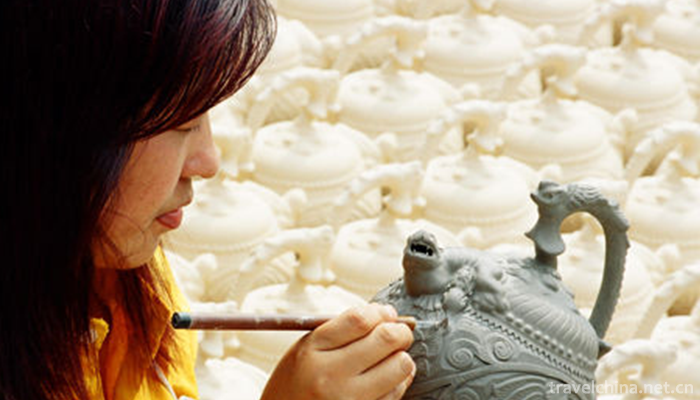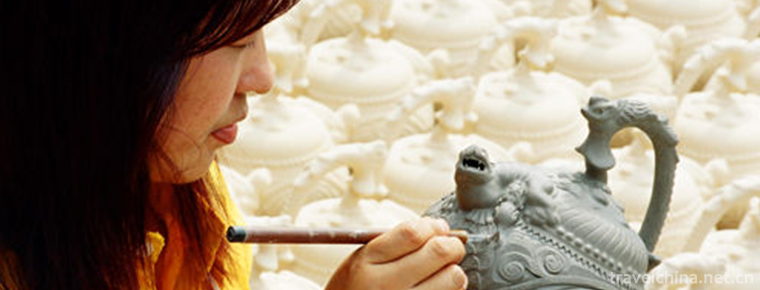Firing Techniques of Yaozhou Kiln Ceramics
Firing Techniques of Yaozhou Kiln Ceramics
Yaozhou kiln ceramic firing technology, the traditional handicraft of Tongchuan City, Shaanxi Province, is one of the national intangible cultural heritage.
Yaozhou kiln is a treasure of Chinese traditional ceramic technology. It was created in the Tang Dynasty and matured in the Five Dynasties. It reached its peak in the Song Dynasty and declined gradually in the Yuan Dynasty. However, the kiln fire has lasted for thousands of years and its salary has been passed on continuously.
On May 20, 2006, the firing technology of Yaozhou kiln ceramics was approved by the State Council and listed in the first batch of national intangible cultural heritage list, item number_-8.
historical origin
Yaozhou kiln ceramics firing techniques first appeared in the Tang Dynasty, Tang Dynasty firing black, white, blue, brown, yellow, tea foam, glaze porcelain, and white glaze green color, white glaze brown color, plain embryo black flower, blue glaze painting white porcelain. The shape of the utensils is full and large, reflecting the prosperity of the Tang Empire. In addition, Tang Sancai and glazed tiles were also fired, which was the most abundant kiln in China at that time.
In the Fifth Dynasty, the kiln mainly burned celadon. The celadon firing process has been mature. The green glaze has grey green, blue green, azure and light azure tones. It also burns a small amount of black and sauce glazed porcelain. Beautiful shape, more imitation of gold and silver. Often used to pick or scratch flowers, making a variety of vivid and smooth patterns. Dragon and phoenix patterns specially designed for Royal porcelains were found in the patterns of porcelains. Several pieces of celadon with the inscription of "official" were also found. The discovery of these beautiful ceramics is the only systematic ceramics archaeological data of the important celadon kilns in northern China during the Five Dynasties.
Song Dynasty was the heyday of celadon firing in this kiln. After entering the Song Dynasty, in order to maintain and develop its leading position in northern celadon in the late Tang and Five Dynasties, maintain the original sales market and compete for new market, the kiln has made great innovations and innovations in the process of making ceramics.
After the Song Dynasty, Yaozhou kiln continued to burn porcelain for hundreds of years. In the early Jin Dynasty, the kiln continued the firing of celadon in Song Dynasty, and highlighted the innovation of moon-white glazed celadon. Later on, the firing of turmeric glazed celadon focused on the middle and lower classes of the people. The firing process highlighted the number of non-glazed ring overlapping firing process, decorative patterns also tended to be concise.
In the Yuan and Ming dynasties, the kiln tended to decline. On the one hand, it continued to burn turmeric glazed celadon, on the other hand, it gradually strengthened the firing of black, white, sauce, tea foam glazed porcelain and white ground black flower porcelain. In the firing of various colored glazed pottery, white ground black flower pottery was the representative work of the kiln in this period. So far, the firing of celadon in this kiln has declined obviously. Shortly afterwards, the kiln burned, and it disappeared on its original historical stage. After the Jin and Yuan military disasters and the turbulent changes of various dynasties, all pottery farms have ceased to burn. Only Chenlu Town has continued to become a major pottery town in Northwest China.
Technological characteristics
Fetal quality
In Tang and Five Dynasties, the fetus was loose, grey, and the enamel was opaque; in Song Dynasty, the celadon was thin, grey-brown or grey-purple, the enamel was transparent, the glaze was green as olive, and the glaze was turmeric; in Jin and Yuan Dynasty, the fetus was slightly thick, the fetus was light grey or grey, and the glaze surface was mostly turmeric, but the glaze was less turmeric. The enamel is thin but not moist.
pattern
The decorative techniques are mainly engraving and printing. The engraving is particularly exquisite. The knife method is sharp and fluent, strong and strong, and has a strong three-dimensional sense. Decorative art, decorative rich and colorful. The patterns include animals, figures, flowers and patterns. The animals in the pattern are dragon, phoenix, lion, rhinoceros, horse, sheep, dog, crane, goose, duck, fish, Mandarin duck, etc. Characters include baby play, Buddha statues, Lishi and so on. Flowers include lotus, peony, chrysanthemum, plum, aquatic plants, etc. There are eight cinnamon patterns, triangular patterns, palindromes and so on. In decoration, before the Five Dynasties, it was simple and generous; in Song Dynasty, it was rich and varied, with exquisite skills and excellence; in Jin and Yuan Dynasties, it became simpler and simpler.
Technological process
The traditional technology of Yaozhou kiln is mainly embodied in seven aspects: raw material collection, ingredient and processing, mud storage and kneading, hand drawing and dressing, hand carving, engraving, decals, printing, glaze medicine selection, preparation and application, boxes, kiln furniture production and kiln installation, flame atmosphere and firing.
The completion of a product involves 17 processes, such as material collection, selection, weathering, proportioning, pad mud, stale, cooked mud, rubbing mud, hand-pulled blank, trimming, glaze selection, preparation, glazing, manual decoration (carving, carving, pasting, printing), kiln production, kiln installation, kiln firing, etc. Each process has corresponding technical requirements, and those who master the relevant skills are called "craftsmen".
Inheritance and Protection
Inheritance value
Yaozhou kiln is the main origin of celadon in the north. It was listed as a tribute in the Song Dynasty and exported to all parts of the world. It has far-reaching influence in the history of ceramics development. Although Huangpu Kiln, known as Shili Kiln Farm, declined in the Yuan Dynasty, its rich connotation, complete preservation and clear cultural overlapping relationship are a precious heritage of Chinese ancient ceramic art. Only Chenlu Town has become an important ceramic town in Northwest China after Huangpu Kiln.
Yaozhou kiln, as one of the six famous kilns in ancient China, occupies an important historical position in the history of Chinese ceramics and even in the history of world ceramics. Its typical decorative technique, celadon carving, reached its peak in the late Northern Song Dynasty, and is also known as the "crown of celadon carving in the Song Dynasty".
Current situation of inheritance
In recent years, under the impact of modern industrial products, the ceramics industry in Chenluzhen was once depressed. In addition, young people went out to work, and older "craftsmen" died one after another. As a result, the traditional ceramics technology, which has been spreading for more than a thousand years, is facing the danger of no one to follow and is in urgent need of rescue.
Heritage figures
Meng Shufeng was born in Yinchuan, Shaanxi Province in 1955. Master of Chinese Arts and Crafts. Senior Arts and Crafts Artist. He is a visiting researcher of the Chinese Academy of Art. Jingdezhen Ceramic Institute. Visiting Professor of Pingxiangshan University, Vice President of Beijing International Association for Scientific, Technological and Cultural Exchange, Secretary-General and Executive Vice-President of China Ceramic Masters Union. In 1980, he graduated from Jingdezhen Ceramic College. He is a ceramic artist who can practice mud, specially glaze, make billets, carve, carve, cut, pick, paint and burn kilns in the creation of traditional Chinese ceramics. On June 5, 2007, Meng Shufeng was selected as the representative successor of the first batch of national intangible cultural heritage projects and declared in Tongchuan City, Shaanxi Province.
protective measures
After the founding of the People's Republic of China, Chen Luzhen Workshop became a state-owned ceramics factory. In the 1970s, with the help of Li Guozhen and other experts, the traditional skills of Yaozhou kiln were restored. Six series of ceramics, including Yaozhou celadon, black glaze and flower-picking porcelain, white glaze and flower-picking porcelain, orchid porcelain, rust flower porcelain and flower glaze, were produced, which became the pillar industries of Tongchuan City.
social influence
Domestic dissemination
The firing and decoration techniques of Yaozhou kiln have a great influence on all parts of the country. In addition to a large number of imitation firing kilns in Shaanxi Province, its skills have also been transmitted to Linru, Yuxian, Baofeng, Neixiang kilns in Henan Province, Xicun kiln in Guangdong Province and Yongfu kiln in Guangxi, forming a huge kiln system headed by Huangbao town kiln.
Important Exhibitions
On April 28, 2017, "Fan Jinzhuo Yuyao Millennium-Yaozhou Kiln Exhibition of Ceramic Exhibits of All Dynasties" opened in the second Hall of the Changsha Museum, exhibiting 116 sets of fine ceramics of all dynasties of Yaozhou Kiln and 65 specimens.


-
2.Shangrao Lingshan Scenic Area
Shangraolingshan Scenic Area, located in the north of Shangrao County, Shangrao City, Jiangxi Province, is a national scenic spot with an area of 160 square kilometers. Lingshan is listed as the "
Time 2018-12-19 -
3.Maoling Museum
Maoling Museum is located on the Wuling Platform between Xianyang and Xingping in Shaanxi Province, about 40 kilometers away from Xi'an. It is a Museum of Dynastic History of the Western Han Dynasty
Time 2019-02-07 -
4.Niangziguan Scenic Area
Niangziguan is a famous pass of the Great Wall of China, known as the Ninth Pass of the Great Wall of China, and it is a must for military strategists of all dynasties.
Time 2019-02-07 -
5.Shui Dong gou
The Shuidonggou scenic spot in Ningxia is the earliest Paleolithic cultural site excavated in China. It is known as the birthplace of Chinese Prehistoric Archaeology
Time 2019-02-08 -
6.Cangzhou Lazi
Cangzhou Laozi is a traditional folk dance with strong local characteristics in the central area of Hebei Province. Laozi is one of the representative folk dances in Hebei Province.
Time 2019-04-04 -
7.Lusheng music
Lusheng is one of the core musical instruments in Miao traditional music culture. In the long history of Miao music practice, its cultural function is not limited to universal musical instruments, bec
Time 2019-05-15 -
8.Circus
Circus is one of the acrobatics. Originally, it refers to the performance performed by people on horses. Now it is a general term for the performance of various wild animals and domesticated birds. It
Time 2019-05-16 -
9.Wenshui Tiaozi
Wenshui Biaozi is an ancient and unique traditional folk music art spread in Wenshui County, Shanxi Province. It is named for its special copper cymbals commonly known as "Biaozi" in perform
Time 2019-06-29 -
10.Firing Techniques of Yaozhou Kiln Ceramics
Yaozhou kiln is a treasure of Chinese traditional ceramic technology. It was created in the Tang Dynasty and matured in the Five Dynasties. It reached its peak in the Song Dynasty and declined gradual
Time 2019-07-11 -
11.Da Zang Temple
Located in the north of malkang County, dazang temple is about 500 kilometers away from Chengdu City and is located in the deep mountains above 3000 meters above sea level.
Time 2020-11-07 -
12.A summary of Panzhihua
In 2019, the GDP of Panzhihua will reach 101.013 billion yuan, an increase of 6.3% over the previous year in terms of comparable prices. In terms of industries, the added value of the primary industry was 9.168 billion yuan, an increase of 3.4%; the added value of the secondary industry was 55.074 billion yuan, an increase of 5.7%; the added value of the tertiary industry was 36.771 billion yuan, an increase of 8.5%.
Time 2020-12-14